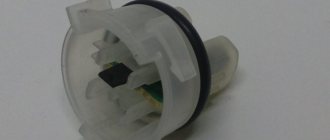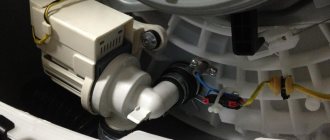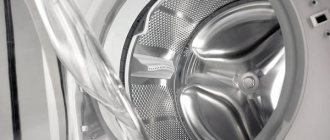Many of us have encountered this situation: when removing dishes with wet hands or touching the metal parts of the dishwasher body, a slight electric shock is felt. Conventionally, the reasons for this behavior of the device can be divided into two groups. The first is associated with internal damage to the unit, the second is caused by faulty wiring or incorrect connection to the network. Why does the dishwasher electrocute from time to time, and what should I do in this case? In our article we will try to provide answers to these questions.
Can I fix it myself?
Any work with electricity is dangerous to human health and life. Therefore, all manipulations for connecting and repairing electric stoves must be carried out by craftsmen who have a special permit to work with electrical equipment.
When handling any electric stove, you must follow safety rules. To do this, you need to de-energize it, i.e. remove the plug from the socket. It is strictly forbidden to carry out any manipulations with the internal parts of the electric stove if it is turned on, especially if you are wearing wet clothes and shoes, barefoot or with wet hands.
In addition, if you decide to repair the stove yourself, you will need a special set of tools and spare parts for repairing electrical equipment. Not every owner has all the necessary tools. And also knowledge! An inexperienced person trying to repair something can cause even more damage to the equipment. And then the repair will be more complicated and cost much more.
Engine breakdown
The current leakage problem may be due to a faulty motor. If a breakdown is observed in new equipment, immediately take it to the store. Such malfunctions often arise due to the fault of the seller due to improper storage and transportation of equipment. If the unit receives an electric current due to engine wear, then it needs repair.
You can also carry out self-diagnosis using a multimeter. But this is a complex procedure that requires specific skills and knowledge. It’s better to immediately call a technician from the service center and not risk the dishwasher. A specialist will test the equipment and replace the damaged winding.
Damage to electrical wiring
If the hood begins to shock, this may mean that its body is under a slight electrical voltage. In other words, electric current leaks onto the walls of the housing. This may be due to damage to the electrical wiring. If such damage is present in the hood, then its further use becomes dangerous.
To find out, it is necessary to carefully inspect the wiring to examine the integrity of the insulating material. If exposed wires are detected, they must be insulated, avoiding close contact with the device body.
Kitchen hoods must be connected to the electrical network with three wires: phase, neutral and ground. The ground wire has yellow insulation with a green stripe. When installing the hood, this wire is connected to the corresponding terminal, which is indicated by a sign in the form of a pyramid - 3 lines of different lengths.
Grounding the hood is not a problem if the house has special grounding sockets. But the majority of residential buildings in our country are not equipped with such sockets, since grounding was not mandatory in the USSR. In modern residential complexes it may also be absent.
To find out whether the house has a grounding system, you need to contact the Housing Office. If there is such a system, there must be a special wire on the distribution panel. Then three-channel electrical wires should be used to connect the sockets, and they will all be connected to ground.
Where there is no standard grounding, it must be done. You should find “ground” on the electrical panel at the entrance. This will most likely be a metal pin threaded onto a pipe. The ground wires are attached to this pin. From this grounding it is necessary to connect a wire to the place where the hood is installed. Its cross-sectional area must be at least 2.5 square meters. mm. It is better not to disconnect the remaining ground wires. It is recommended to connect the hood itself to the mains through a separate circuit breaker with a resistance of 6 Amps.
Creating grounding on your own is a rather troublesome task that requires appropriate knowledge. If you entrust the solution to this problem to an amateur, the consequences will most likely be quite dire. Therefore, it is better to turn to professionals for help. It is also necessary to take into account that replacing electrical wiring and sockets will require significant financial investments.
Does "earth" work?
Let's say all three wires are provided, including ground. Then you need to check whether the “ground” in a particular outlet is working properly. You can do this yourself using a multimeter, a “test lamp” or an indicator screwdriver. In the first case, we act like this.
- We turn on the electricity supply through the panel.
- We switch the tester to voltage measurement mode.
- We insert one multimeter probe into the expected phase, and the second into zero. We write down the result.
- We move the second probe from zero to “ground” and carry out a similar measurement.
If the last measurement shows a figure almost identical to the first, then grounding in the apartment is present and fully operational. A blank display indicates the opposite - the ground wire is either missing or damaged.
If you don’t have a multimeter at hand, you can “ring” the grounding using the so-called test lamp. It is assembled from scrap materials: an ordinary “Ilyich light bulb” is taken, and two wires with limit switches that react to current are connected to its socket. You should not focus only on the color of the insulation - there is a high probability that the electrician neglected the markings or mixed up the shades. Then we proceed like this:
- we touch one end of the phase, and direct the other to zero;
- remember how hard the lamp burns;
- move the tip from zero to ground.
We compare the light received from the lamp with the first case. If it also lights up, the grounding is working properly; if there is no ignition or it is much weaker, there are problems with the grounding wire.
In a similar way to the lamp, the “ground” is checked using an indicator screwdriver. Let’s not forget about indirect evidence that the house is “jamming” or there is no grounding. For example, a water heater or washing machine will periodically generate electric current, and when listening to music on speakers, extraneous noise will arise.
Causes of electric shocks
A washing machine is not the only appliance that can give users an electric shock. Refrigerators, electric kettles, dishwashers and other household appliances connected to the electrical network can become a source of danger. The device stings or receives an electric shock due to electrical leakage on the body. There are several reasons for this phenomenon:
- Wiring faulty. This is a real danger for users. A damaged cable, in contact with the housing, poses a threat whenever a person touches it. It is necessary to immediately inspect the internal wiring.
- Damp atmosphere. Equipment does not like dampness. And washing machines have to work directly with water. Most often they are installed in bathrooms, where it is quite humid. Water is an excellent conductor of electricity. If your hands are wet, then when you touch the body, you can feel a tingling sensation. This effect is not anomalous - it happens with almost all washing machines. Moreover, this happens more often with modern models. The claim here must be made that not all houses are equipped with grounding.
- If the engine or heating element breaks through. The breakdown goes to the body. The solution is to immediately replace the broken parts.
Tags
Dishwasher Why dishwasher Why dishwasher Dishwasher repair operation. The dishwasher The dishwasher beats the dishwasher time of the machine itself the dishwasher periodically the dishwasher must The dishwasher is that the machine beats a wiring fault or a wiring fault a wiring fault change the wiring no The heating element needs to be inspected The heating element needs to be replaced insulation. The wires need to be replaced carefully.
resistance must be installed ways to connect the breakdown
Why is my dishwasher electrocuted?
When you touch the PMM body, do you feel a small discharge? Don't ignore the problems - they are very serious. With such symptoms, the causes of problems are divided into two types:
- Internal malfunctions of equipment, which causes breakdown.
- External problems related to network connection errors.
If your equipment has been in operation for a long time, the following parts may short out:
Electric motor PMM. The insulation of its winding may be damaged.
The heating element breaks through to the housing.
The integrity of the insulation of internal wiring is broken.
When a new, just installed dishwasher breaks, look for the reason in the electrics:
- The machine is connected to an outlet without grounding.
- The socket itself is faulty.
Operating errors, poor-quality water and network interruptions lead to damage to internal elements. Below we will describe how to correct the situation. In the meantime, unplug your dishwasher.
Don't forget about safety rules!
In order not to completely damage the device, and first of all, not to harm yourself, you should always remember the safety rules:
- Before looking for the cause of the breakdown or starting repairs, the device must be disconnected from the network;
- Do not touch the dishwasher with wet hands while it is plugged in;
- Do not install the device in a room with high humidity;
- If damage to the insulation is found on the wiring, socket or plug, it is better not to turn on the dishwasher.
How to check the heater
Often the reason why a Bosch dishwasher is electrocuted is a hole in the heater. In order to confirm this version, you will need to remove it, you can do this as follows:
- disconnect devices from the power supply and drainage system;
- remove the dish baskets, garbage filter and sprinklers from the tank;
- if there are screws under the mesh, remove them;
- turn the machine over so that the bottom is accessible to you for manipulation;
- remove the bottom;
- disconnect the heating element from the pipe;
- disconnect all existing wires from the heater;
- pull out the heater and inspect it (sometimes this is enough to confirm that there is a problem).
If a visual inspection does not produce results, bathe the heating element in a saline solution, and then measure the resistance between the heater and the solution. To do this you need to take a multimeter. If it shows resistance, then the heating element is broken. In this case, it will have to be replaced.
There is another way to check the heating element; it is recommended to use it if the dishwasher is electrocuted and the problem is not solved.
Dishwasher repair
To do this you will need:
- set to Ohms on the device.
- attach a multimeter to the contacts of the heating element;
- if the part functions normally, its resistance will be in the range of 21-22 ohms.
To check the heater for current leakage, you will need to switch the device to Megaohm. Then attach one multimeter probe to the contacts of the heater, and the second to the body. With a working heating element, the device will show infinite resistance.
How to properly care for your dishwasher
Regular care of your dishwasher can extend its service life. If you want to. To ensure that plates are washed efficiently and equipment breaks down less often, then follow our recommendations. We will tell you how to clean your dishwasher at home.
Daily care for PMM
If you constantly use equipment without proper care, sooner or later it will fail. Filters, hoses and pipes may become clogged, and leakage may occur as the seals become clogged. What measures does daily prevention include:
- After finishing washing, leave the hopper door open. This will help the moisture evaporate faster and prevent mold from forming.
- Wipe the door sealing rubber with a dry sponge.
- Clean the outside of the dishwasher with a damp cloth.
Also, once or twice a week, do the following:
- cleaning the drain and inlet filters;
- cleaning the upper and lower sprinklers;
- cleaning the inside of the bunker;
- inspection and cleaning of hoses;
- Cleaning the detergent compartment.
Use only special dishwasher detergents. These can be tablets, powder or gel capsules. Also use dish rinse aid.
Be sure to add special salt to the PMM. You can find many varieties of salt on store shelves. It allows you to soften water, purifying it from harmful impurities and reducing the likelihood of scale formation.
Chemical cleaning of PMM
Chemicals can rid the insides of the dishwasher of limescale (scale), rust, mold and mildew. For these purposes, you can use home remedies that you make yourself:
- take 400 g of soda;
- 3 tbsp. l. peroxides;
- 20 drops of essential oil.
Make balls from this composition and place them on the bottom shelf. Mix 400 g of vinegar with a spoon of cleaning gel and place on the top shelf. Start the washing program. We recommend not using this product often, since the smell of vinegar is difficult to remove.
Important! Care is carried out the same way for dishwashers of any brand: Bosch (Bosch), Siemens, Ariston, Indesit and others. But it is best to use specialized tools
For example Calgonit Fusion Power, Finish Rinse and others.
Simply pour the required amount of product (as indicated in the instructions) into the compartment, select a program for at least 1.5 hours and a temperature of up to 60 degrees.
Interesting! It has been proven that the service life of equipment doubles if chemical and manual cleaning is carried out every six months.
Manual dishwasher care
Be sure to clean the elements and parts yourself. How to care for the internal parts of the machine:
- Open the hopper door and remove the drain filter. There may be a mesh behind it, remove that as well. Rinse the parts under pressure from the tap; for stubborn dirt, use a brush.
- Behind the filter is the pump impeller.
- Use a sponge to pump out the water from the hole, unscrew the screws and remove the pump cover. Inspect and clean the impeller of debris.
- Remove the sprinklers from their seats.
- Use a toothpick to clean the injectors and rinse with water.
- Use a wet sponge and detergent to wash all baskets, shelves, holders, and the walls of the dishwasher. Don't forget the door and powder tray.
- Disconnect the drain and inlet hoses and rinse. Clean the inlet filter and the flow filter, which is located near the tee.
- The external PMM panel can be treated with glass liquid.
RCD connection
Experts recommend not limiting yourself to installing grounding, but connecting an RCD. The power of the device depends on the total power consumption of the line it serves. This device will protect the whole family from electric shock. When the RCD is turned on, the house is under control: as soon as problems arise with the wiring, the device turns off the electricity, preventing damage.
Can I get an electric shock if an RCD is connected? In addition to the power of the RCD, the consumer should be interested in the cutoff parameters. It depends on them how hard it will be hit before the cutoff is triggered. The lower the cutoff, the more protected the user is. For a bathroom, an RCD with a cutoff of 10 mA is suitable; for other sockets, 30 mA will be sufficient. The bathroom is humid, so the cutoff parameters are lower. Before installing the device, you will have to lay new wiring or install the RCD directly into the distribution board.
Important! Installing an RCD prevents electric shock, but does not eliminate the causes of breakdown
Incorrect network connection
If you are not a fan of reading the rules of connection and operation, then it is possible that you made a mistake at this stage. Go back to the brochure and check if everything was done according to the instructions. The connection of some models may vary, as well as technical specifications. Therefore, one dishwasher does not give an electric shock, but the second one can give a shock under the same conditions. The only requirement for all dishwashers is a grounded outlet. Connecting such equipment without grounding is life-threatening.
Take into account such a protection method as RCD. This is a residual current device
It looks like a circuit breaker, but it protects you, not the wiring. It will be needed if it is impossible to change the wiring. The RCD stops the supply of electricity in dangerous cases; it will not save you from an electric shock, but it will make the shock much smaller.
Causes
Why is the dishwasher electrocuted? Yes, because there is a current leakage onto the body of the machine. All the reasons for this can be divided into two groups, the first group is associated with a malfunction of the machine itself and most often occurs after some time of using the equipment. The second group of reasons is associated with improper connection of the dishwasher, or rather with the electrical network. At the same time, even a new machine can start to “bite”. We list all possible reasons:
- the insulation of the wiring inside the dishwasher is broken;
- the engine of the car is broken;
- heater breakdown;
- the socket is faulty;
- there is no grounding.
Checking the heating element
Most often, the reason that a car is electrocuted lies in a broken heating element. To check it, you need to remove the heater, for this you need:
- disconnect equipment from the network and water supply;
- remove the dish baskets, garbage filter and sprinklers from the tank;
- if there is one, unscrew the screws under the mesh (at the bottom of the tank);
- turn the dishwasher over so that you can access its bottom;
- remove the bottom;
- we find the heater and disconnect it from the pipe;
- disconnect all the chips with wires from the heating element;
- we take out the heater and inspect it; already at this stage a breakdown can be detected;
- To verify the malfunction, you can lower the heating element into a salt solution, and then measure the resistance between the heater and the solution. If the device shows resistance, it means the heater is broken.
- if there really is a breakdown of the part, replace the heater with a new one.
The second way to check the heater is dry as follows:
- set the unit of measurement on the multimeter to Ohms;
- apply the probe of the device to the contacts of the heater;
- a serviceable part has a resistance within 21-22 Ohms, a faulty one has an infinite resistance;
- after checking the heater, check the part for current leakage to the body, switching the multimeter to MegaOhms for this;
- We place one probe of the device on the contact of the heater, and the second on its body. It can be applied not to the body, but to the grounding contact. If the heater is working properly, there should be infinite resistance on the device.
How to check wiring and motor
It seems clear why the dishwasher shocks you, but what do you do when it behaves like this? Quite often the leak is caused by wiring or the engine housing. In our practice, there have been cases when mice appeared in the dishwasher and, gnawing on the wiring, created a similar problem.
Even if there are no mice in the machine, the bulk wiring inside could be defective, with damaged insulation, or the insulation has become frayed over time
Visually inspect each wire, especially pay attention to the bases of each wire where they connect to chips or terminals. If you find a damaged wire, replace it
If you have the skill, you can use a multimeter. It also helps in finding a damaged wire, but visual inspection has not been canceled. If the wiring is OK, check the engine. If the winding leaks onto the housing, then the engine may well begin to shock. This can also be checked easily using a multimeter. A broken winding is not suitable for further operation; the motor will have to be replaced. You can, of course, try to rewind the part, but this will cost more.
So, you shouldn’t ignore this problem with your dishwasher. But how to fix it, make a decision yourself, call a technician or look for and fix the problem yourself. Just remember, you need to be extremely careful with electricity!
What to do if there is a breakdown on the body?
First of all, think about how you connected the dishwasher to the network. It is unacceptable to turn on such powerful equipment without grounding. Only this saves the device from leakage of current to the housing, thus protecting the user from injury.
Important! The PMM must be connected to a European-type socket with grounding contacts.
Carrying carriers and extension cords are not permitted. Often they cannot withstand the stress, melt and ignite. Therefore, it makes sense to install a European socket near the device.
Install an RCD machine. When shorted, it will turn off the operation of the equipment. And if a discharge does occur, the machine will reduce its power and duration.
If you have connected according to all the rules, then inspect the outlet. The contacts inside could have oxidized, which leads to a similar problem. Clean them to restore the machine's functionality.
Diagnostics and replacement of heating elements
Often the heating element of a Bosch dishwasher fails for two reasons:
- Poor quality water.
- Power surges in the network.
“Hard” water contains a large number of impurities. These are potassium and magnesium salts. When heated, they settle on the surface of the heater, forming a thick layer. As a result, the part malfunctions: it either burns out or begins to penetrate the PMM panel. The same applies to changes in the network.
To check the heating element, you need to remove the bottom panel of the housing. The flow element is connected to the pump.
- Disconnect the device from electricity.
- Turn off the water supply.
- Disconnect communications.
- Remove the trays from the hopper and remove the spray nozzles.
- On some models, the heating block is secured with five screws on the bottom.
- Remove the drain filter.
- Remove the screws.
Cover the floor with a towel or rag to prevent damage to the cabinet. Turn the PMM on its side. Remove the bottom. Be careful, a float sensor may be attached below. Unfasten its wiring.
- Unclench the clamp and remove the pipe from the seat of the heating element.
- Disconnect the wiring connectors from the heater.
- Inspect the part for damage.
To diagnose the heating element for breakdown, you will need a multimeter. Set the toggle switch to resistance measurement mode.
- Attach the probes to the contacts of the part.
- If the heating element is working, the display will show from 21 to 22 Ohms.
- If it is faulty, infinity will be displayed.
The broken part cannot be repaired, install a new element.
Electric motor and wiring repair
Both the engine and its wiring can penetrate the housing. Service center technicians gave an example of mice infesting the dishwasher. They chewed through the wiring, which created a leak into the housing.
The presence of mice is accompanied by a specific smell that is difficult to miss. A visual inspection of the unit will also not hurt.
- After disconnecting the device from communications, remove the bottom.
- Several pipes lead to the circulation pump.
- Unclench their clamps.
- Remove from place.
- Unfasten the chips.
You need to look closely at the wires. Not only the motor, but also other elements. Perhaps the insulation is broken somewhere, which is creating the problem. The damaged cable is replaced.
If the integrity of the motor winding is damaged, it also leaks. You can test the part with a multimeter to identify damage. Some users hand over the motor for rewinding. But it will cost more than replacement. Therefore, if there is a malfunction, it is better to replace the unit.
Don't forget to follow simple safety rules:
- Do not touch the cabinet with wet hands.
- Do not install the machine in a room with high humidity.
- Do not continue operation if you notice damage to the insulation.
You can inspect the equipment yourself. But we recommend contacting a specialist to repair the PMM.
What current is dangerous?
The human body is a complex conductor, consisting of organs and tissues with different electrical conductivities. Household electric current, passing through the body, can frighten, harm health and even kill. The outcome of the “meeting” depends on the path of the current and its strength. It is especially dangerous when passing through the brain, heart, and lungs. The degree of damage also depends on the magnitude and type of electric current. Variable is more dangerous than constant. Namely, it is used in household networks.
A current value of 15 mA is considered dangerous. In a household outlet it is from 6 A. A shock of 50 mA can cause serious damage. Exposure to 100 mA for 1–2 seconds can cause cardiac arrest.
How does the problem manifest itself?
There are as many reasons why an electric shock occurs as there are variations in how it happens. This may be a barely noticeable tingling sensation, as with electrophoresis, or it may be a rather strong and painful shock.
First, let's figure out which parts of the machine contact with can lead to unpleasant symptoms.
- When a person touches water with any part of the body. For example, if you take wet laundry out of the drum.
- Contact with water mixer.
- Touching the machine body.
- When touching a drum or homemade ground.
Any of these signs indicate a malfunction inside the machine, and current is a serious matter. Such incidents create a significant danger to the life and health of the machine operator. Therefore, it is necessary to fix the problem and urgently! Of course, this is not the case when you need to do something yourself. The only thing you need to do quickly is to disconnect the machine from the power supply and do not turn it on until the technician arrives.
What should I do to fix the problem?
There are various methods you can use to eliminate static electricity problems. The main one is the installation of strips made of graphite or aluminum with a rubberized insert. One edge of such a tape will be in contact with the body, and the other with the ground. These strips operate on the principle of a lightning rod. Then the electricity accumulated in the metal body of the car will “merge” into the ground.
If you encounter such a problem, check the material from which the upholstery of the seats in the cabin is made. If there are covers made of wool or synthetics, then the problem is often eliminated by simply replacing them.
If you don’t want to get rid of your favorite cases, try using special antistatic sprays. Use them to treat the surface of the covers, and then the possibility of an electrical discharge will be minimized.
Dry clean the interior and wet clean the inside of the car. Dry air masses inside the car provoke the accumulation of electricity on your clothes. Wet conditions will help reduce the risk of electric shock.
A temporary measure, if it is not possible to carry out the above procedures, may be the following action: before leaving the car, touch any metal part in the cabin, and only then open the doors. This simple procedure will help you avoid discomfort.
If, after performing all the recommended procedures, the car still receives an electric shock, it is obvious that the reason lies in the on-board electrical distribution system. Then eliminating it yourself is no longer so easy. A competent solution to the problem is possible with the help of specialized specialists. You can find them at any service station. For safety reasons, you should not attempt repairs yourself.
It is imperative to get rid of this problem. And the point is not only in the unpleasant sensations for a person, but also in the fact that such a phenomenon is quite capable of causing a car fire. And despite the fact that the likelihood of gasoline vapor coming into contact with an electric spark is small, there is still a risk, and it is better to eliminate it.
You can feel the electric shock from the water jet
Let's figure out what to do depending on the cause of the problem. Only a master can determine this and make repairs. Here's some data:
- If electrical parts, such as heating elements or a motor, become unusable, they must either be repaired or even replaced with new ones, just to be sure.
- The insulation of the internal wires is broken, causing the current to come into contact with other parts. In this case, only repair will help.
- Interaction of contact with other parts due to increased humidity. In this case, you need to install grounding or change it if it is already in place, but does not help.
- Neighbors use a water pipe as a ground electrode. Then you will have to install your own grounding device, as well as contact a special service, since using the pipe as a working ground is unacceptable.
There are also situations when water or the machine continues to shock when disconnected from the power supply. It would seem like a mystery. But no, it's simple. Most likely, these are problems with the wiring, and not necessarily in the user’s habitat. The floor slab may contain elements of moisture and allow current to pass from another apartment to yours.
Grounding the machine in a private house
Grounding a dishwasher with your own hands in a private home is a little more difficult. The difficulty is that there is no common house grounding, so it is necessary to make a grounding loop and properly bury it in the ground. But this can be done if you follow the following instructions:
- We retreat at least 1 meter from the external wall of the house and determine the place for the future contour.
- Using a shovel, we dig a ditch 0.5-1 m deep in the form of a triangle with equal sides of 2 m.
- In each vertex of the resulting triangle we insert a metal pin - a grounding rod. Any piece of metal at least 3 m long will do.
- We put on protective seals and glasses and use a welding machine to connect all the “vertices” with a metal strip.
- We fix a terminal on one of the tops and hook up a copper wire with a cross-section of 3 * 1.5 square meters. mm or aluminum 3*4.5 sq. mm.
- We stretch the wire to the communal panel.
- We bury the structure with earth and trample it down.
You can place parts of the outline as a rectangle or one line - their location does not play a special role.
Next, we proceed in the same way with apartment grounding. We take another piece of suitable wiring and connect the grounded panel and the dishwasher together. We also focus on the special sign located on the back cover of the machine.
Possible causes of malfunction
It must be taken into account that moisture and electricity are always present in the kitchen. Grease, dust and moisture accumulate inside the hood. At high temperatures, all these components create excellent electrical conductivity, so the hood body can “shock.”
If the hood starts to shock, you must first clean its internal elements. To clean the hood, you need to disconnect it from the power supply, disconnect the air duct pipe and electrical wires, and then remove the device itself. The removed hood, depending on the design of the hood, is disassembled to provide access to contaminated elements. They are cleaned with a sponge and soap. After cleaning, the hood is dried and installed back.
Clogged filters also need to be cleaned promptly. Carbon filters for hoods operating in recirculation mode should be changed every 4-6 months (depending on the intensity of use of the device). It is advisable to clean grease filters after 2-3 months of operation.
Pump
Bearing wear for a circular pump causes failure in about half of all cases of problems. The bearing is a small graphite ring and is very vulnerable to constant loads on the equipment. Subject to daily use, the maximum service life of the bearing is 2-3 years.
As soon as the bearing's service life expires, the pump will begin to seize and the machine will begin to make an obnoxious hum. At first, this circumstance does not in any way affect the performance of the dishwasher, however, over time, the pump will cope with the task of pumping and supplying water more and more poorly. This means it's time to start repairing the equipment.
The pump is repaired according to the following scheme:
- Unplug the machine
- Remove the pan to get to the pump
- Unscrew the clamps and remove the chip
- Carefully disconnect the pump from the wiring and pull it out
Ready. you can start disassembling.
- Carefully remove the heater unit. Keep in mind that it is tightly screwed on and will require some effort to remove it. Try not to damage anything when removing the part, be careful.
- After removing the impeller, pull out the armature using pliers or tongs
Ready! You have reached the bearing. Now you should carefully remove it, preferably using tweezers. We have to check the integrity of the rubber gasket. When the gasket wears out, it loses its elasticity and a powdery coating forms on the surface. Since the gasket is made of rubber, most likely it will be intact, but the bearing will have to be replaced in any case. Ready! Now you can reassemble the machine in reverse order.
Methods of protection
To prevent the washing machine from electrocuting, it is worth making a grounding connection. Also eliminate all faults in the unit itself. Experts recommend protecting yourself by doing the following:
- By setting the residual current device to 30 or 10 mA. At the slightest electricity leak, the RCD will trip. If the washing machine starts to generate current, then the automation on the panel will work and the power will simply turn off. This should only be installed on three-wire wiring. Otherwise, the RCD will trip very often. You will have to constantly walk and turn on the automation. In such situations, it is recommended to install an outlet that has a residual current device.
- It is necessary to do regular grounding integrity checks. This is required for user safety. In some cases, equipment produces electric shock even when grounded. This may indicate conductor damage. The grounding cable should be checked and repaired regularly.
If you experience an unpleasant sensation when touching the faucet or while washing your hands, you should immediately turn off the power in the bathroom and start looking for the problem. It is strictly forbidden to look for a fault when there is voltage in the network.
Incorrect electrical connection
One of the reasons leading to the machine receiving an electric shock may be a violation of the rules for connecting the device to the electrical network.
Before installation, carefully read the operating instructions for the dishwasher. Manufacturers set their own connection rules, since the technical characteristics of all devices are different. But there is a general recommendation that applies to all models: the device should be connected to the power supply only through a Euro socket with reliable grounding.
Operating principle of RCD
If there is no European socket, then it makes sense to install it, at least in the room where you plan to connect the dishwasher. The idea of replacing the factory Euro plug with a “Soviet” one should be immediately abandoned for reasons of electrical safety. In addition, you automatically void the product warranty. In modern apartments, instead of grounding, grounding is often done: the wire is connected to a solid neutral. Under no circumstances try to do this yourself - it won’t take a specialist much time, but it could cost you your life.
If changing the wiring is not possible, use a residual current device that will cut off the power supply in the event of a leak.
An RCD will not save you from electric shock, it will only reduce its strength. Before installation, carefully read the operating instructions to determine which type of device is suitable for your model.
How the hood works
To understand the reason why the hood is not working, you need to have basic knowledge about the design of the device, its operating principle and technical features. The main element of all hoods is the electric motor that rotates the fan. The air flow created by the fan draws out fumes and odors generated during cooking.
There are two types of fans used in hoods: axial and tangential. The air flow passes through filters, on which odors and fatty fumes are deposited.
Manufacturers offer two types of hoods: filtering (recirculation) and exhaust. The first type of hoods cleans the air of odors and smoke and then returns it to the room.
Exhaust hoods remove contaminated air outside the kitchen. Most modern hoods can operate in both recirculation and exhaust modes.
Determining the type of hood is quite simple. The exhaust outlets have a special outlet for connecting the air duct, while the recirculation outlets do not have it. If possible, it is better to connect the hood to the ventilation system, as this increases the efficiency of air purification.
Air purification is carried out using filters. Immediately behind the air intake grille there is a grease filter, and behind it is a carbon filter. The latter is designed to absorb odors. Grease filters can be reusable or disposable, but reusable mesh metal grease traps are most widely used.
In addition to filters and a fan, the hoods also have a control panel and a lighting system.
The control can be mechanical or touch, and different types of lamps are installed in the backlights. The most advanced models are equipped with LED lamps and a variety of sensors that monitor the operation of the equipment and report on its condition.
How to determine grounding
Basic provisions
Before making grounding, you should find out if it is in the house. Open the panel that shows your connection to the public power line and turn off the electricity in your apartment. Only when the room is de-energized can you begin checking.
Take a closer look to see if the yellow-green wire is connected to the terminal of the outlet you are interested in. The blue and brown wires (zero and phase) connected to the terminals indicate that there is no grounding by default in a private house or high-rise apartment.
Also pay attention to the jumper located between zero and the terminal responsible for grounding - if it is present, it means that later the electrical wiring in the kitchen was grounded, which is very dangerous for household members
How to determine the serviceability of the existing grounding
Let there be three conductor components placed in screw terminals. It's time to start checking the correct operation of the grounding in this outlet. To do this, you need to arm yourself with a special device - a multimeter, with the help of which the following manipulations are later carried out:
- Turn on the power to the panel.
- Lock the tester in voltage measurement mode.
- Determine the voltage that occurs between phase and zero.
- Take the same measurements between phase and ground.
If different values are reflected on the multimeter, there is a grounding connection; there is no need to do it. But if nothing is displayed on the display, this means that there is no grounding, or there is, but is inoperative.
The readings between phase and ground will be different
If a multimeter is not at hand, a control device in the form of a self-constructed light bulb will come in handy. It consists of a cartridge, two wires and end switches that fit onto the wires. Touch one wire to the terminal responsible for the phase, and the other to the zero. When determining where the phase is and where the zero is, do not rely on the color of the insulation - we cannot exclude the possibility that the previous master made a mistake and swapped them. It is advisable to check the correctness with an indicator screwdriver.
As soon as the control lamp lights up upon contact with the terminals, place the tip of the wire, aligned with the neutral, to the ground antenna. The light is still on - the grounding is working as expected, if the light is weak - the condition of the circuit leaves much to be desired. It happens that when grounding, a residual current device is additionally connected - in this case, the RCD will definitely trip.
The fact that there is no grounding or it needs to be corrected can also be indicated by the water heater not operating fast enough, or, for example, the automatic washing machine is electrocuted. If there is no ground connection, music comes out of the speakers, accompanied by additional noise.
Troubleshooting errors
Many inexperienced technicians make a lot of mistakes when fixing problems. If the washing machine is electrocuted, the problem should be solved immediately, as people may be injured. What should you not do?
- If there is no grounding cable in the living room, then flipping the plug in the outlet will not help. A bath mat made of rubber will not protect you from electric shocks. You can do similar methods as much as you like, but they still won’t fix the problem. The problem still remains.
- Disable the device's surge protector. It is this element that directs part of the electricity to the body of the washing machine. Many believe that disabling this filter will save the user from problems. This also doesn't solve the problems. Perhaps the device will shock less often.
- Connect the grounding cable to the battery or to the riser. This is strictly prohibited. This grounding method is dangerous.
If household appliances regularly shock, then you can turn to qualified specialists for help. They will quickly find the cause of the problem and fix it. If you do not have sufficient knowledge, then entrust the organization of grounding in the house to an experienced electrician.
What not to do?
Owners of washing machines should know what measures should not be taken if the washing machine produces an electric shock.
If there is no grounding, turning the plug in the socket will not bring a positive outcome. The unit operates on AC power, so changing the polarity does not play any role for it.
A rubber mat near washing equipment will also not protect against electric shock. The thing is that the electrical potential will not disappear anywhere, so the user can receive an electric shock by touching the body of the unit or its other parts.
Turning off the network filter will not help. This part of the washing unit supplies electricity to the body of the equipment. However, in normal mode, its voltage is considered safe and is not felt by a person.
Grounding the machine body to the heating system will not only create a threat to the people living in the apartment, but also to the entire house. Only a special conductor must be grounded.
The risk of electric shock may be present when using any electrical appliance, including a washing machine. Since this is a dangerous situation, the problem should be solved immediately after discovery. Specialists who can easily find the source of the problem and quickly eliminate it can help in this situation. You can also correct the situation yourself, but only if you have certain knowledge and experience.
To solve the problem of electric shocks from a washing machine, see below.
Repair of electric stoves by professionals
has been repairing and servicing electric stoves of various brands for more than 10 years.
When you contact us, you are guaranteed to receive:
- Qualified repair of electric stoves from any manufacturer (even outdated and discontinued models).
- A technician will visit your home.
- Convenient service time. To be agreed in advance with the client.
- Complete diagnostics of the electric stove.
- Only original spare parts.
- Warranty for all types of work and installed parts.
- Payment according to receipts, with a description of each type of service and the cost of spare parts.
You can call a specialist at your home by calling 8(495)707-05-05 from 7:00 to 23:00 or by filling out an application on the website.









